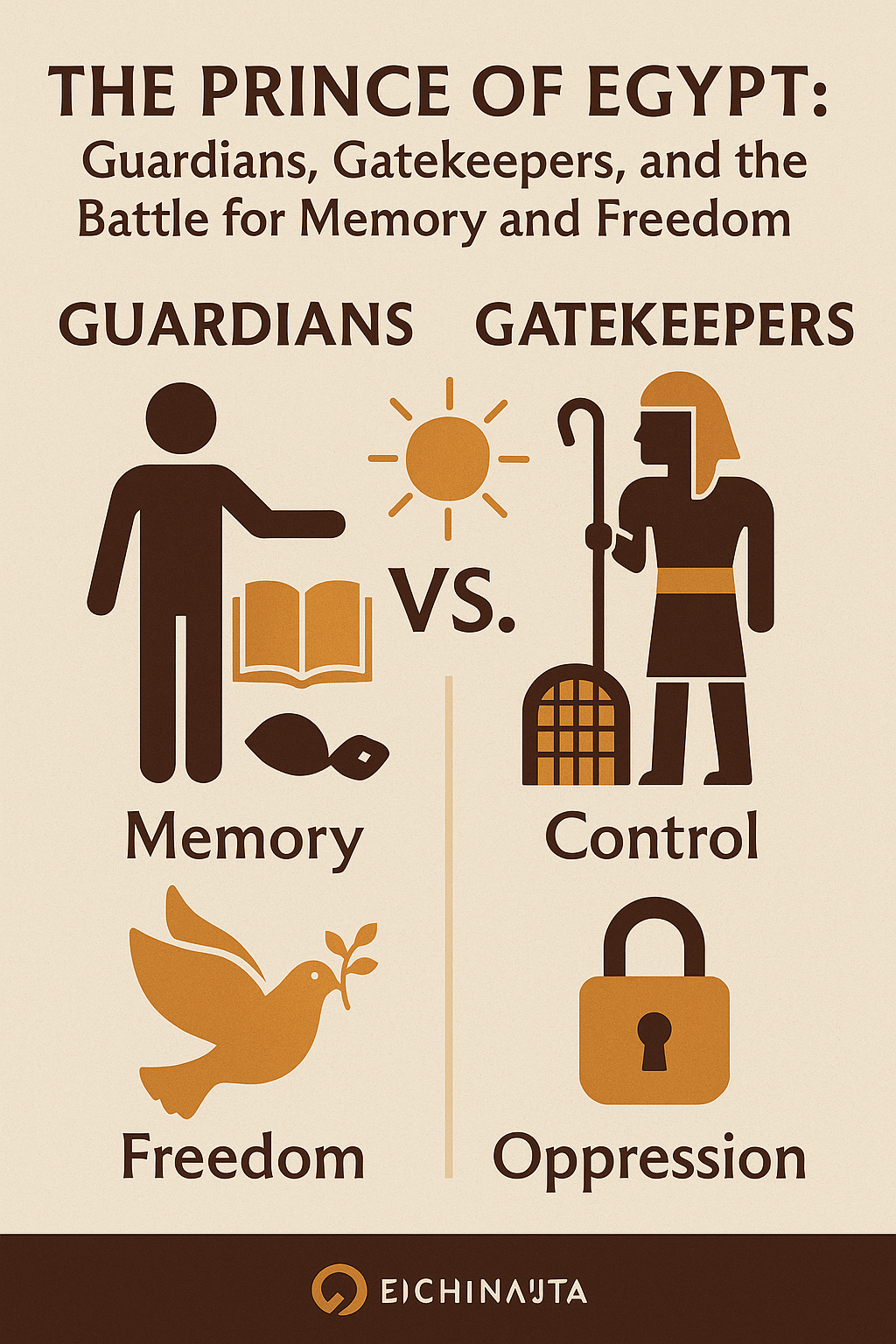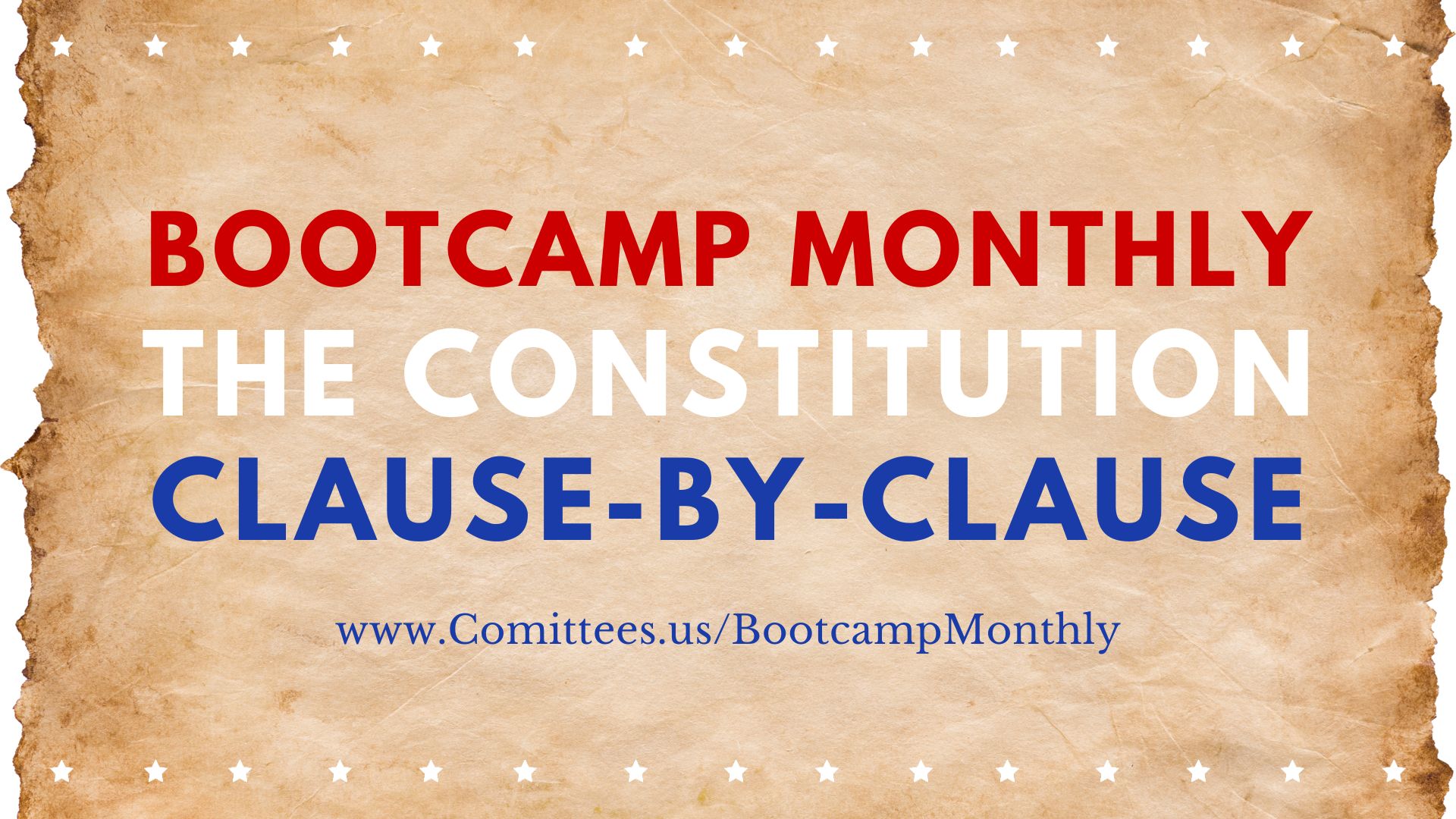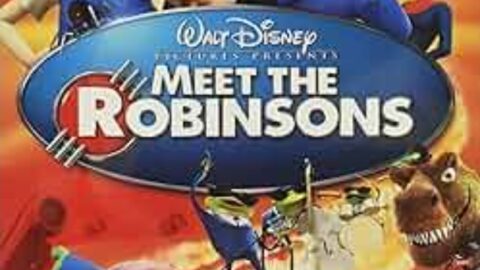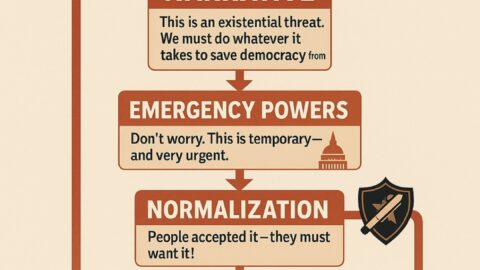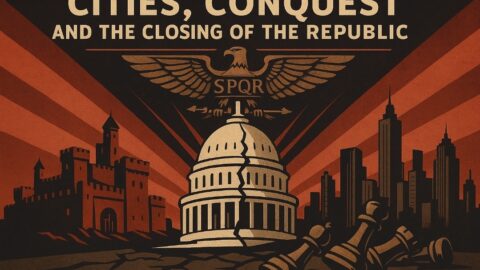DreamWorks’ The Prince of Egypt is more than an animated retelling of the Exodus story. It is a parable of timeless themes: identity vs. illusion, memory vs. amnesia, guardians vs. gatekeepers, freedom vs. empire, and faith vs. power. Through its characters, the film illustrates the struggles every generation faces between truth and control, conscience and obedience, dignity and domination.
Moses: The Transitional Character
Moses begins as a confident prince of Egypt, his identity built on lies. “All I ever wanted” is the palace life, power, and belonging he has always known. But Miriam’s revelation — that he is the child of slaves, saved by his mother Yocheved — shatters that illusion. Moses flees in despair, only to encounter God in the burning bush.
His journey is one of transformation: from privilege to humility, from blindness to sight, from fugitive to liberator. Moses represents the transitional character — the one who breaks cycles of denial and deception, preserving memory against empire’s amnesia. He becomes the radical guardian who refuses obedience to Pharaoh in order to obey God: “Let my people go.”
Rameses: The Tragic Gatekeeper
Rameses is Moses’ foil. Insecure as the “weak link,” he clings to power and tradition. His father Seti defined him by dynasty and fear: “One weak link can break the chain.” When Pharaoh, Rameses becomes enslaved to the very system he rules. He insists, “I am the Morning and the Evening Star!” — not because he is strong, but because he is terrified of weakness.
Rameses embodies the gatekeeper. His role is not to liberate but to maintain the system, enforce tradition, and protect empire at all costs. He loves Moses as a brother, yet cannot release control. His tragedy is that his chains are invisible: he is Pharaoh, but he is not free.
Miriam and Yocheved: The Guardians of Memory
The true heartbeat of the story lies with the women.
- Yocheved, by placing Moses in the river, entrusts him to God. Her lullaby becomes the spiritual thread of the entire narrative.
- Miriam, as a child, watches over him; as an adult, she reminds him of his true identity: “You are not a prince of Egypt. You are our brother.”
They embody memory against amnesia. In a world where Pharaoh rewrites atrocities as “necessary sacrifices,” they preserve the truth through song, story, and faith. Without their voices, Moses would have no anchor to his real identity.
Aaron: The Fearful Pragmatist
Aaron is the embodiment of despair. Living under slavery his entire life, he cannot imagine freedom. When Moses returns with God’s commission, Aaron doubts: “When did God start caring about any of us?” His role is essential, because he represents the temptation to surrender to hopelessness, to accept chains as inevitable. Yet even Aaron is swept into faith as miracles unfold.
Seti: The Architect of Amnesia
Pharaoh Seti is the cold logic of empire personified. He justifies the slaughter of Hebrew infants as “sacrifices for the greater good.” He teaches his sons that monuments and dynasty matter more than individual lives. Seti’s legacy is a world where atrocity is normalized and forgotten. He is the architect of cultural amnesia — erasing conscience to preserve empire.
Tzipporah: The Radical Outsider
Tzipporah begins as a slave humiliated in Pharaoh’s court, but she refuses to bow. She later becomes Moses’ wife and partner, reminding him of human dignity and grounding him in family. As a Midianite, she represents a different way of life — free, communal, and outside Egypt’s machine. She embodies the voice of the outsider who shows that slavery is not natural and freedom is possible.
God: The Eternal Guardian
Above all stands God — I Am That I Am. Where empire relies on monuments, armies, and tradition, God speaks into history with promises, memory, and deliverance. God is the eternal guardian of truth and covenant, raising deliverers when human guardians alone cannot break the chains of empire.
The Themes Woven Together
- Identity vs. Illusion – Moses finds his true self when he rejects Pharaoh’s false narrative.
- Memory vs. Amnesia – Miriam’s song preserves what Pharaoh tries to erase.
- Guardians vs. Gatekeepers – Moses, Miriam, Yocheved, and Tzipporah guard truth; Seti, Rameses, and the priests enforce lies.
- Conscience vs. Obedience – Liberation requires breaking blind obedience to unjust authority.
- Freedom vs. Empire – Egypt thrives on collectivism and depersonalization; God restores individuality and dignity.
- Power vs. Faith – Pharaoh has monuments; Israel has faith. In the end, faith outlasts empire.
- Fear vs. Hope – Fear enslaves; hope sustains.
- Women as Guardians – Deliverance begins with Yocheved’s sacrifice, Miriam’s courage, and Tzipporah’s defiance.
The Final Lesson
The Prince of Egypt teaches that history is not written only by kings and monuments, but by guardians of memory who refuse to forget. Pharaohs, dynasties, and empires crumble, but conscience, song, and faith endure.
Every generation must choose:
- Be a guardian — preserving truth, freedom, and dignity, even at great cost.
- Or be a gatekeeper — enforcing lies and protecting systems of oppression.
The film’s final vision is clear: “Look at your people, Moses. They are free.” The question it leaves for us is just as clear: Whose side are we on?
The Prince of Egypt: Character Development and Themes
Moses – The Transitional Character (Guardian of Memory & Freedom)
- Arc: Moses begins as a privileged prince, oblivious to injustice. Through Miriam’s revelation and his own confrontation with Pharaoh’s crimes, he awakens to truth. His exile, humility, and encounter with God make him a guardian of memory and liberator of the enslaved.
- Theme: Moses represents the individual who chooses conscience over comfort. He breaks from systemic lies, embraces his true identity, and becomes the radical who restores truth and freedom.
- Guardian Role: Carries memory (of Yocheved’s sacrifice, Miriam’s song, God’s covenant) into action. Moses is the antidote to amnesia and gatekeeping.
Rameses – The Gatekeeper of Tradition and Power
- Arc: Insecure as the “weak link,” Rameses becomes Pharaoh bound by tradition and fear of weakness. His identity is defined by the system and his father’s expectations. He clings to control, even as plagues devastate Egypt.
- Theme: Rameses embodies the gatekeeper mentality — preserving power structures at any cost, enslaving truth, resisting change. His tragic flaw is pride and fear of losing control.
- Gatekeeper Role: Protects the Overton Window of empire (“they are only slaves”), ensuring continuity of oppression. He cannot transcend his role, and in doing so, he destroys what he sought to protect.
Miriam – The Voice of Memory
- Arc: As a child, she risks everything to protect Moses. As an adult, she reminds him of who he truly is. Miriam anchors Moses’ identity in truth when he wavers.
- Theme: Miriam symbolizes the preservation of memory across generations. Her lullaby bridges past and future.
- Guardian Role: Keeps alive the knowledge of deliverance even under slavery — a prophetic role against cultural amnesia.
Aaron – The Fearful Pragmatist
- Arc: Skeptical and resentful, Aaron often doubts Moses. His attitude reflects the despair of those crushed by slavery: “When did God start caring?”
- Theme: Aaron embodies the cautious realist who fears rocking the boat. He represents those trapped in survival mode, reluctant to believe in deliverance until miracles force conviction.
- Gatekeeper Role (at first): By discouraging Miriam and questioning Moses, Aaron plays the unintentional role of a gatekeeper who lowers expectations and protects the status quo.
Pharaoh Seti – The Architect of Amnesia
- Arc: Seti embodies cold empire logic: genocide as “sacrifice for the greater good.” His love for his sons cannot hide his cruelty.
- Theme: Seti symbolizes the oligarch’s deception — using power, fear, and tradition to erase conscience. He enforces forgetting, rewriting history as necessity.
- Gatekeeper Role: He sets the mold for Rameses. By normalizing atrocity, he makes mass amnesia a pillar of Egyptian rule.
Yocheved – The Guardian Mother
- Arc: She sacrifices her son to the river, entrusting him to God. Her lullaby becomes the through-line of the entire story, echoing until Israel’s liberation.
- Theme: Yocheved represents faithful guardianship — choosing memory and hope over despair. Her voice becomes the seed of Moses’ awakening.
- Guardian Role: Preserves life, faith, and memory even under tyranny.
Tzipporah – The Radical Outsider
- Arc: First defiant as a slave-girl mocked by the court, then later Moses’ wife, she embodies courage and freedom. Her Midianite background represents a different, freer order.
- Theme: Tzipporah shows that freedom is normal, slavery is not. She reminds Moses of human dignity and supports his calling.
- Guardian Role: Helps Moses embrace humility, humanity, and the vision of a family-centered future beyond empire.
God – The Ultimate Liberator
- Arc: God breaks into history with power and compassion, revealing Himself as I Am That I Am. He commissions Moses, confronts Pharaoh, and delivers His people.
- Theme: God is the eternal Guardian of truth and covenant. Unlike the gatekeepers of empire, He cannot be bribed, silenced, or overturned.
- Guardian Role: Keeps the promise, raises deliverers, sustains hope, and ultimately proves that no empire is eternal.
Guardians vs. Gatekeepers in The Prince of Egypt
- Guardians (Moses, Miriam, Yocheved, God, eventually Aaron, Tzipporah): Preserve memory, resist lies, protect human dignity, act in faith.
- Gatekeepers (Seti, Rameses, Priests Hotep & Huy): Protect empire, enforce amnesia, mock faith, weaponize tradition.
- Tension: The story is not just Pharaoh vs. Moses — it is amnesia vs. memory, obedience vs. conscience, empire vs. covenant.
The Themes of The Prince of Egypt
1. Identity vs. Illusion
- Moses: Begins as a prince, confident in an identity built on lies. His crisis comes when Miriam reveals his true origin. The collapse of his illusion (“All I ever wanted”) forces him to wrestle with who he really is.
- Rameses: Clings to his role as Pharaoh because it is his only identity. “I will not be the weak link!” He fears that without power and tradition, he is nothing.
- Theme: Identity formed by empire and lies collapses under the weight of truth. Only identity rooted in God and memory survives.
2. Memory vs. Amnesia
- Miriam & Yocheved: Carry memory forward through lullaby and song, refusing to forget the covenant. Miriam sings Moses back into remembrance when he’s lost.
- Seti & Rameses: Represent cultural amnesia — rewriting atrocities as “sacrifice for the greater good” or dismissing them as “slaves.”
- Theme: Oppressors depend on amnesia to survive; liberation depends on memory being kept alive.
3. Guardians vs. Gatekeepers
- Guardians: Moses (after awakening), Miriam, Yocheved, Tzipporah, God Himself. They preserve truth, dignity, and conscience.
- Gatekeepers: Seti, Rameses, Hotep & Huy. They maintain order, enforce lies, and guard tradition against truth.
- Theme: Every society has guardians of conscience and gatekeepers of control. The struggle between them defines history.
4. Conscience vs. Obedience
- Moses: Breaks obedience to Pharaoh in order to obey God. His defining moment is striking the Egyptian, then later confronting Rameses: “Let my people go!”
- Rameses: Obeys tradition, his father’s legacy, and his own fear. His inability to listen to conscience destroys him.
- Aaron: Represents hesitation—obedience to survival vs. awakening conscience.
- Theme: True liberation requires breaking blind obedience to unjust authority.
5. Freedom vs. Collectivism (Empire)
- Egypt: A machine of slavery, monuments, and propaganda. Individual lives mean nothing compared to the “chain of dynasty.”
- Hebrews: Cry out for dignity, identity, and freedom. They embody the principle that every human is more than a cog.
- Theme: Empire thrives on collectivism and depersonalization; God restores freedom and individuality under His covenant.
6. Power vs. Faith
- Seti & Rameses: Trust in monuments, armies, bloodline, and “tradition.”
- God & Moses: Call for trust in the unseen — faith in promises, not pyramids.
- Miriam & Tzipporah: Voices of faith when Moses falters.
- Theme: Power can take food, homes, even lives — but it cannot extinguish faith.
7. Fear vs. Hope
- Aaron: Fearful, pragmatic, unable to see beyond oppression.
- Miriam: Hopeful, prophetic, singing deliverance into being.
- Rameses: Fear of weakness drives his cruelty.
- Theme: Fear enslaves; hope liberates. The oppressed survive because of hope preserved through song, prayer, and memory.
8. The Role of Women as Guardians
- Yocheved: Preserves Moses’ life.
- Miriam: Preserves Moses’ identity.
- Tzipporah: Preserves Moses’ humility and humanity.
- Queen Taya: Protects Moses as her son.
- Theme: Women are the unsung guardians of memory and identity — without them, deliverance could not happen.
Character Arcs and Thematic Embodiment
- Moses: Transitional character — from illusion → truth → calling. Guardian of freedom.
- Rameses: Tragic gatekeeper — from insecurity → tyranny → destruction. Preserver of empire.
- Seti: Cold oligarch — sacrifices children for “greater good.” Architect of amnesia.
- Miriam: Prophet of memory — awakens Moses’ identity and sustains hope.
- Aaron: Pragmatist — trapped in fear, reluctantly carried forward by miracles.
- Yocheved: Mother of deliverance — her lullaby is the movie’s spiritual anchor.
- Tzipporah: Outsider-turned-partner — grounds Moses in dignity and family.
- God: The Eternal Guardian — intervenes when human guardianship alone is not enough.
The Final Weave
The Prince of Egypt shows that history is shaped not by monuments or dynasties, but by memory, conscience, and faith.
- Guardians preserve these threads.
- Gatekeepers suppress them.
- Every person must decide: Will I guard memory and truth, or protect the empire of lies?

